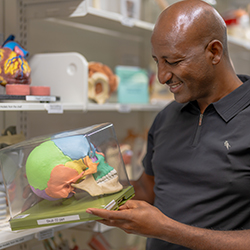
Fossil Study Answers Questions Regarding Dietary Changes in Human Ancestors

As a result of selection and adaptation over the course of millions of years, diverse life-forms consistently drive alterations. Through examining fossils, changes over time can be identified — even behavioral changes such as dietary shifts.
Chalachew Seyoum, PhD, assistant professor in the University of Arizona College of Medicine – Phoenix’s Department of Basic Medical Sciences, explored that phenomenon in a new study published in Science.
To solve how dietary changes shifted the morphology of primates, Dr. Seyoum and his team focused on a specific behavior in the fossil record of some primates. By reporting carbon and oxygen isotope ratios from fossil cercopithecid monkeys, they found that changes in graminivorous behavior preceded changes in dental morphology by 700,000 years.

“With every organism, there is a change in morphology and a change in our adaptation, a change in our diet and other things,” Dr. Seyoum said. “This study is showing that sometimes behavioral and morphological changes can happen successively, instead of concurrently.”
Dr. Seyoum states that there has been a dietary shift in the human lineage from a C3 dominated diet, which mostly consisted of plants that utilize the C3 carbon fixation pathway, to more grass and sedge based C4 diet. According to Dr. Seyoum, dietary change is linked to climate and habitat change.
Two obstacles remain in detecting behavioral drive-in fossil records. It is challenging to quantify behavior independently of the morphological trait, and behavioral drive sequences can vary in duration, thereby eliminating a chronological offset.
However, Dr. Seyoum and his team overcame these obstacles by focusing on the consumption of C4 plants in primates, with the absence of adequate adaptations that are in most graminivorous mammals.
By examining the oxygen isotopes of fossils and placing the data within the context of dietary evolution, Dr. Seyoum and colleagues found that graminivorous behavior came about 700,000 years before the changes in dental morphology.
Technological advancements have allowed studies such as the one conducted by Dr. Seyoum to explore questions about the past. Although much remains uncertain, future data and technology may facilitate more innovative research.
“Many years ago, we did not have the privilege to sample isotope data, and we were not in a position to achieve this kind of outcome,” Dr. Seyoum said. “Now this type of data analysis is becoming increasingly common. However, additional fossil data is needed to better understand our past and fill in the gaps.”
About the College
Founded in 2007, the University of Arizona College of Medicine – Phoenix inspires and trains exemplary physicians, scientists and leaders to advance its core missions in education, research, clinical care and service to communities across Arizona. The college’s strength lies in our collaborations and partnerships with clinical affiliates, community organizations and industry sponsors. With our primary affiliate, Banner Health, we are recognized as the premier academic medical center in Phoenix. As an anchor institution of the Phoenix Bioscience Core, the college is home to signature research programs in neurosciences, cardiopulmonary diseases, immunology, informatics and metabolism. These focus areas uniquely position us to drive biomedical research and bolster economic development in the region.
As an urban institution with strong roots in rural and tribal health, the college has graduated more than 1,000 physicians and matriculates 130 students each year. Greater than 60% of matriculating students are from Arizona and many continue training at our GME sponsored residency programs, ultimately pursuing local academic and community-based opportunities. While our traditional four-year program continues to thrive, we will launch our recently approved accelerated three-year medical student curriculum with exclusive focus on primary care. This program is designed to further enhance workforce retention needs across Arizona.
The college has embarked on our strategic plan for 2025 to 2030. Learn more.